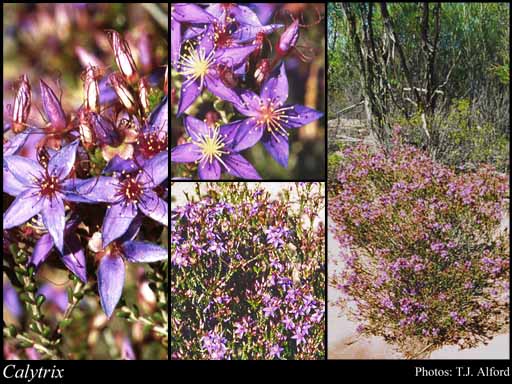- Reference
- Nov.Holl.Pl. 2:8,Tab.146 (1806)
- Name Status
- Current







Scientific Description
Common name. Starflowers. Family Myrtaceae.
Includes Calythropsis and Lhotskya.
Habit and leaf form. Trees, or shrubs; evergreen; bearing essential oils. Plants with neither basal nor terminal concentrations of leaves; to 0.1–3 m high. Leptocaul. Helophytic to xerophytic. Heterophyllous, or not heterophyllous. Leaves minute to small; alternate (commonly), or opposite, or whorled (in C. verticillata); decussate; ‘herbaceous’, or leathery; imbricate, or not imbricate; petiolate to sessile; gland-dotted; aromatic; edgewise to the stem, or with ‘normal’ orientation; simple; peltate, or not peltate; epulvinate. Leaf blades dorsiventral, or isobilateral, or centric; entire; flat (? when lunate), or solid; terete, or semi-terete, or solid/angular; linear, or lanceolate, or oblong, or ovate; linear, or ovate, or oblong, or elliptic; pinnately veined, or parallel-veined, or one-veined; cross-venulate, or without cross-venules. Mature leaf blades adaxially glabrous, or pubescent; abaxially glabrous, or pubescent. Leaves with stipules, or without stipules. Stipules mostly minute. Leaves without a persistent basal meristem. Leaf anatomy. Hairs present, or absent. Unicellular hairs present, or absent. Stem anatomy. Secondary thickening developing from a conventional cambial ring.
Reproductive type, pollination. Fertile flowers hermaphrodite. Unisexual flowers absent. Plants hermaphrodite. Entomophilous, or ornithophilous. Pollination mechanism conspicuously specialized, or unspecialized.
Inflorescence and flower features. Flowers solitary (apparently), or aggregated in ‘inflorescences’. The terminal inflorescence unit cymose. Inflorescences axillary; a monad, the plant with one to many monads per branchlet. Flowers (bi) bracteolate. Bracteoles deciduous, or persistent (and in some species connate for up to most of their length). Flowers small to large; regular; cyclic. Free hypanthium present (petals ‘inserted on the calyx’); campanulate (and short), or tubular (and long); not extending beyond ovary, or extending beyond ovary; often forming a narrow tube around the style and sometimes adnate to the style. Hypogynous disk present (lining the hypanthium). Perianth with distinct calyx and corolla, or petaline; 4, or 10; 1 -whorled, or 2 -whorled; isomerous. Calyx present, or absent (in C. ecalycata); 5; 1 -whorled; polysepalous, or gamosepalous; lobed; imbricate; regular; often with an apical awn; persistent, or not persistent (rarely). Sepals ovate, or obovate, or triangular, or orbicular. Calyx lobes ovate, or obovate, or triangular, or orbicular. Corolla present; 5, or 4 (in C. ecalycata); 1 -whorled; polypetalous; imbricate; regular; plain, or with contrasting markings; white, or yellow, or pink, or purple; deciduous. Petals elliptic, or oblong, or ovate, or linear. Androecial members definite in number, or indefinite in number (usually). Androecium 6–150. Androecial members branched, or unbranched. Androecial sequence determinable, or not determinable. Androecial members if ‘many’, maturing centripetally; free of the perianth; all equal, or markedly unequal; free of one another; 1–5 -whorled. Androecium exclusively of fertile stamens, or including staminodes (where the connective is increased in size until the anther consists of only sterile connective tissue). Stamens 6–150; attached on the rim of the hypanthium; becoming exserted; all more or less similar in shape; polystemonous (usually); alternisepalous and oppositisepalous; both opposite and alternating with the corolla members; erect in bud (or rarely a few in each bud inflexed). Filaments not geniculate; filiform. Anthers all alike; dorsifixed; versatile (although in some species the connective is developed downwards restricting anther movement); dehiscing via longitudinal slits; introrse; tetrasporangiate; appendaged, or unappendaged. Gynoecium 2 carpelled. The pistil 1 celled. Gynoecium syncarpous; eu-syncarpous; inferior, or partly inferior. Ovary unilocular; 1 locular. Epigynous disk present, or absent (when perigynous). Gynoecium stylate. Styles 1; simple; apical; persistent, or deciduous. Stigmas 1; capitate (to subcapitate), or punctiform. Placentation axile- basal (C. praecipua unique in the genus in having vestiges of a septum). Ovules in the single cavity 2, or 3–4 (in C. praecipua); ascending; collateral; non-arillate; anatropous.
Fruit and seed features. Fruit non-fleshy; indehiscent; a nut (the hypanthium in fruit morphologically little changed from the hypanthium in flower); 1 seeded. Seeds non-endospermic; obovoid. Cotyledons 2; plano-convex at the apex of the thickened hypocotyl. Embryo straight. Testa membranous.
Geography, cytology, number of species. Native of Australia. Endemic to Australia. Australian states and territories: Western Australia, South Australia, Northern Territory, Queensland, New South Wales, Victoria, Australian Capital Territory, and Tasmania. Northern Botanical Province, Eremaean Botanical Province, and South-West Botanical Province. X=11.
Etymology. From the Greek for "cup, calyx" and "hair"; refers to the long awns, or stiff hairs, terminating the calyx-lobes.
Keys
A Key to Western Australian Species in the Chamelaucieae Tribe of Myrtaceae
B.L. Rye, M.D. Barrett, T.D. Macfarlane, N.S. Lander, M.E. Trudgen, N.G. Marchant, K.R. Thiele
Taxonomic Literature
- Wheeler, Judy; Marchant, Neville; Lewington, Margaret; Graham, Lorraine 2002. Flora of the south west, Bunbury, Augusta, Denmark. Volume 2, dicotyledons. Australian Biological Resources Study.. Canberra..